Brazil Electrocardiograph (ECG) Equipment Market Outlook to 2030
By Product Type, By Technology/Form Factor, By End Use, By Procurement Model, and By Region
- Product Code: TDR0241
- Region: Central and South America
- Published on: August 2025
- Total Pages: 110
Introducing the World's FirstPay-Per-Section Market Reports
Why pay for the full report when you need just a part?
Start Building Your Report
Scroll down to see available sections
Report Summary
The report titled “Brazil Electrocardiograph (ECG) Equipment Market Outlook to 2030 – By Product Type, By Technology/Form Factor, By End Use, By Procurement Model, and By Region” provides a comprehensive analysis of Brazil’s ECG industry. It maps the market’s overview and genesis within Brazil’s mixed public–private health system, quantifies overall market size in value terms, and details segmentation. The report covers trends and developments alongside the regulatory landscape spanning ANVISA, INMETRO/OCP certification per IEC 60601 series, and LGPD data-protection requirements for ECG waveforms and reports. Customer-level profiling distinguishes SUS hospitals vs. private chains and diagnostics networks, outlines purchasing criteria, and maps care-pathway usage. It examines issues and challenges including FX-linked import exposure, tender price compression, integration heterogeneity, service-coverage gaps, and cybersecurity compliance. The competitive landscape analyzes the competition scenario and presents a cross-comparison of leading vendors using ECG-specific parameters, and includes detailed company profiles of global and Brazilian manufacturers. The report concludes with future market projections based on device unit volumes, software/tele-ECG attach rates, consumables pull-through, product categories, procurement models, and regional diffusion. A cause-and-effect framework ties demographic and care-delivery drivers to replacement cycles and digital adoption, while success case studies highlight best practices in public tenders, primary-care ECG rollouts, and tele-ECG network scaling—pinpointing major opportunities and cautions for stakeholders planning investments, partnerships, and go-to-market strategies through 2030.
Brazil Electrocardiograph (ECG) Equipment Market Overview and Size
The Brazil ECG equipment market is valued at approximately USD 210 million in 2023, and it grew at a CAGR of around 7.5% between 2018 and 2023, according to data compiled by Frost & Sullivan and ABIMO-Brazil Association of Medical Devices. The growth is primarily driven by rising cardiovascular disease diagnosis rates, increased investments in primary and tertiary healthcare infrastructure, and growing adoption of AI-enabled ECG systems enhancing diagnostic speed and accuracy.
Major cities such as São Paulo and Rio de Janeiro dominate the ECG equipment market, owing to their high concentration of tertiary—hospital chains, specialty cardiology clinics, and advanced diagnostic labs—and substantial healthcare budgets. Additionally, Brasília and Campinas are key hubs due to government procurement centers and regional medical device distribution networks supporting wide coverage and faster after-sales service.
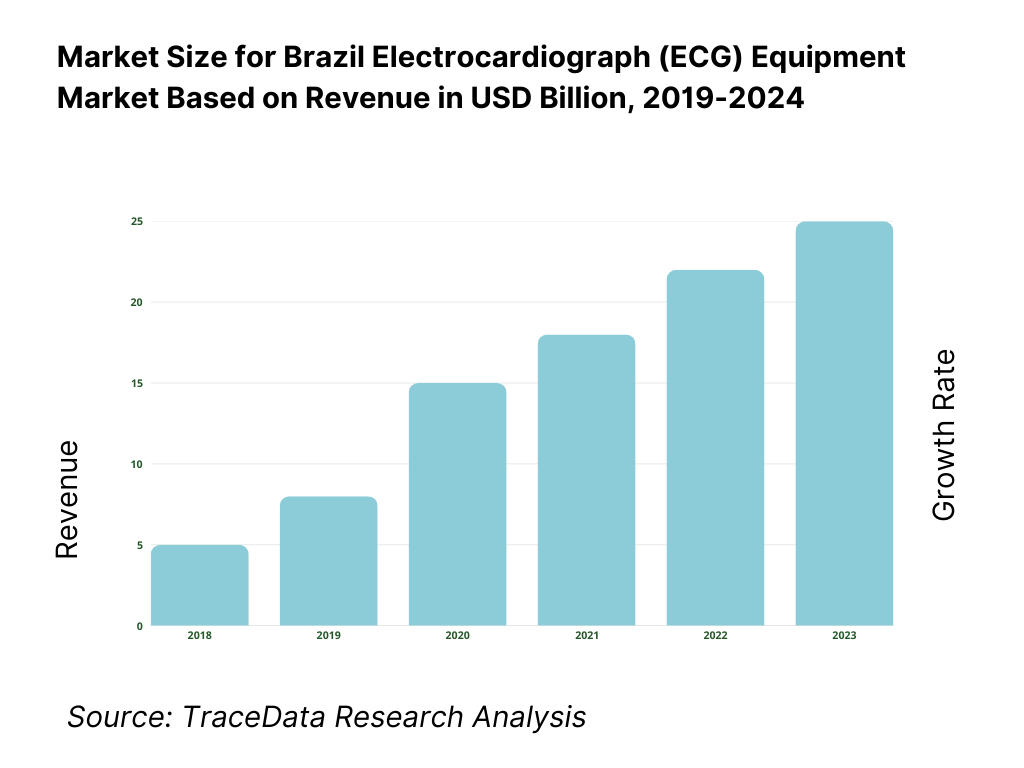
What Factors are Leading to the Growth of the Brazil Electrocardiograph (ECG) Equipment Market:
Rapid aging and high cardiovascular burden fueling ECG demand: Brazil’s demographic and disease profile is a structural growth engine for the Brazil electrocardiograph (ECG) equipment market. The national census confirms 22,169,101 people aged 65+ and 203,080,756 total inhabitants, establishing a large, at-risk cohort for arrhythmias and ischemic disease that require ECG at screening, diagnosis, and follow-up. Projections and official analyses also show the 60+ population reaching roughly 33.0 million contemporaneously, intensifying ambulatory and in-hospital monitoring needs. On the disease side, the Ministry of Health reports ~400,000 deaths from cardiovascular causes in the country, underscoring a persistent clinical load that translates into routine resting ECGs, stress testing, Holter monitoring, and telemetry across SUS and private providers. Together, the sheer scale of older adults plus the confirmed cardiovascular mortality burden creates year-round, multi-setting utilization for ECG hardware, software, and consumables in Brazil’s mixed public–private system.
Expansion of private coverage and nationwide primary-care footprint: Private coverage adds a robust demand channel alongside SUS. The National Supplementary Health Agency reports 52,210,290 people enrolled in medical health plans at the end of the current cycle, a record that concentrates diagnostic investments—ECG carts, PC-ECG, and telemetry—within large hospital chains and corporate clinics. In parallel, the Ministry of Health executed a national Primary Care census and network expansion: communications cite ~50,000 Basic Health Units (UBS) in operation, and the 2024 UBS Census compiled responses from 44,938 facilities, while 3,448 new multiprofessional primary-care teams were deployed. This combination—tens of millions with private access and a dense UBS grid—broadens ECG access points from tertiary centers to community clinics, lifting installed base needs (portable ECGs, Holters) and recurring maintenance and software-license demand across Brazil’s 5,570 municipalities.
Integration into connected care and resilient device supply via trade flows: Brazil is formalizing digital health rails and leveraging international device supply—both favorable for ECG adoption and renewal cycles. The Rede Nacional de Dados em Saúde (RNDS) is the Ministry’s official interoperability backbone for health data exchange, enabling integration of ECG waveforms and reports with EHRs, telecardiology, and remote interpretation services. On the hardware side, Brazil’s medical-device trade confirms ready access to advanced ECG platforms: in the latest reported year, imports reached US$ 9.79 billion and exports US$ 1.17 billion, evidencing active sourcing of diagnostic technologies and components. As cardiology programs scale within SUS and private networks, interoperability plus ample trade channels supports quicker refresh of ECG fleets, cloud-ECG software rollouts, and scaling of ambulatory monitoring services by diagnostics chains and hospital groups.
Which Industry Challenges Have Impacted the Growth of the Brazil Electrocardiograph (ECG) Equipment Market:
Import dependence and currency exposure evidenced by device trade gap: The ECG equipment landscape in Brazil is heavily exposed to international sourcing, making device availability and upgrade cycles sensitive to exchange-rate swings and logistics costs. Official trade statistics show US$ 9.79 billion in medical-device imports against US$ 1.17 billion in exports in the latest year, implying a structural deficit in higher-tech health hardware. For ECG OEMs and distributors, this means elevated working-capital needs for inventories and parts, tighter forecasts on shipment lead times, and ongoing localization pressures for accessories like electrodes and cables. For providers, it can translate into staggered replacement of ECG fleets and slower penetration of premium features (e.g., advanced telemetry, cloud AI) when FX volatility lifts landed costs, even as clinical demand remains high.
Public-sector capacity constraints and infrastructure dispersion: Sustained strain on inpatient capacity complicates large-scale deployments of ECG stress labs and telemetry in the public system. The Federal Council of Medicine reports a decline from 335,000 public inpatient beds to 309,000 over the period assessed, limiting surge capacity for cardiovascular admissions and monitored beds. Even with a broad primary-care footprint (~50,000 UBS and 44,938 units documented in the 2024 UBS Census), regional dispersion and referral bottlenecks slow the flow of patients into comprehensive cardiology pathways. For ECG vendors, this environment requires prioritizing portable and ambulatory modalities (resting ECG, Holter) and robust service coverage in the interior to offset constraints in high-acuity bed availability, while aligning sales cycles with state and municipal procurement rhythms.
Data-protection compliance and active enforcement for ECG data: ECG systems process identifiable clinical data subject to Brazil’s LGPD, and enforcement is active. In December 2024, the National Data Protection Authority announced inspections of 20 companies for governance gaps—signaling operational scrutiny of health data handlers. In April 2024, the ANPD issued Resolução CD/ANPD nº 15, setting a strict 3 business-day deadline to notify incidents to both the Authority and data subjects, which requires ECG software vendors, telecardiology hubs, and hospitals to maintain 24/7 incident response and audit trails. Compliance design (access logs, encryption at rest/in transit, vendor DPIAs) now materially influences ECG procurement and IT integration roadmaps, with breach-response SLAs embedded in contracts to meet the statutory clock.
What are the Regulations and Initiatives which have Governed the Market:
ANVISA device classification and market-entry pathways (RDC 751): ANVISA’s RDC nº 751/2022 governs medical-device classification and regularization, anchoring ECG equipment under a four-tier risk system (Classes I–IV) with two market-entry routes: notification for lower-risk devices (Classes I–II) and registration for higher-risk (Classes III–IV). ECG modalities (resting ECG, Holter, stress systems, telemetry) map to these classes depending on intended use and invasiveness. The resolution also codifies labeling and instructions-for-use requirements, and interacts with updated procedural guidance issued in 2024 for dossier instruction under GGTPS, impacting submission content and review consistency for ECG launches and renewals. Vendors must align technical files and vigilance post-market plans to this framework before commercialization.
INMETRO conformity assessment for electromedical safety (IEC 60601 series): Before commercialization, ECG equipment must comply with INMETRO’s conformity assessment for electromedical products under Portaria nº 384/2020, which consolidates requirements referencing ABNT NBR IEC 60601-1 (general safety) and applicable 60601-2-xx particular standards for performance and essential safety. This demands accredited testing and certification—covering electrical safety, electromagnetic compatibility, and basic safety essential performance—prior to ANVISA clearance. For ECG makers, certification timelines and test reports are binding inputs to regulatory submissions and public tenders, and periodic recertification is required when design changes affect safety/performance, ensuring harmonization with international norms and safer deployment at scale across Brazil’s hospital and primary-care networks.
LGPD enforcement baseline for clinical ECG data (incident notification, governance): Health providers and ECG vendors are data controllers/processors under LGPD and must operate within ANPD’s current rule set. Resolução CD/ANPD nº 15/2024 formalizes incident-notification in 3 business days, mandates content requirements for notifications, and dovetails with the Authority’s ongoing monitoring cycle and sanctions program. Public notices confirm active inspections and sanction decisions posted by the Authority, reinforcing that ECG archives, waveforms, and analysis outputs require documented governance (access control, minimization, data-sharing records) and vendor management frameworks. Procurement increasingly references these obligations, requiring ECG solutions to deliver audit logs, encryption, and incident-response playbooks aligned to the regulation’s timing and scope.
Brazil Electrocardiograph (ECG) Equipment Market Segmentation
By Product Type: The Brazil ECG equipment market is segmented into resting 12-lead ECG machines, stress testing systems, Holter monitors, event recorders, and telemetry ECG modules. Currently, resting 12-lead ECG machines dominate the market in 2024. This dominance stems from their widespread presence across hospitals, outpatient clinics, and primary care units, as well as broader physician familiarity with this traditional format. The high throughput of routine diagnostics and lower unit acquisition cost compared to ambulatory or telemetry systems further reinforce their market leadership.
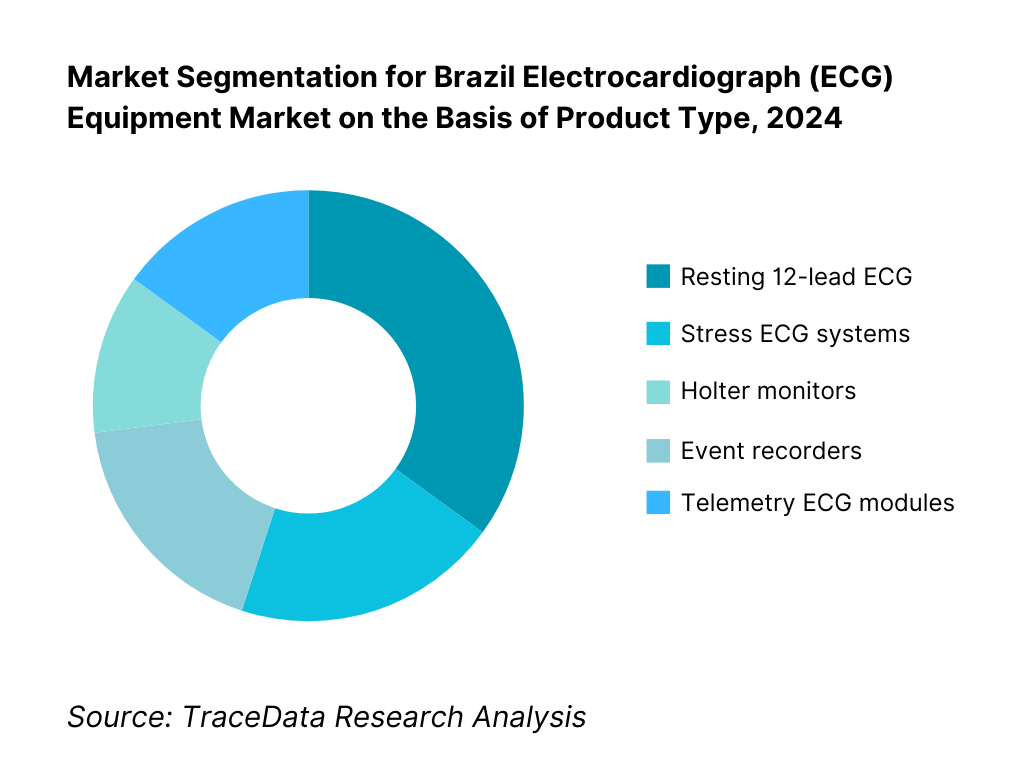
By End-Use / Delivery Mode: Among end-use modalities, the public healthcare sector accounts for the largest share of the Brazil ECG equipment market as of 2024. This dominance is attributable to government-funded procurement programs via SUS, which drive large-volume purchases for hospitals, urgent care centers (UPAs), and UBS units. The public sector’s consolidated procurement model and budgeted acquisition of standard ECG modalities reinforce its leading position compared to more fragmented private and EMS purchasers.
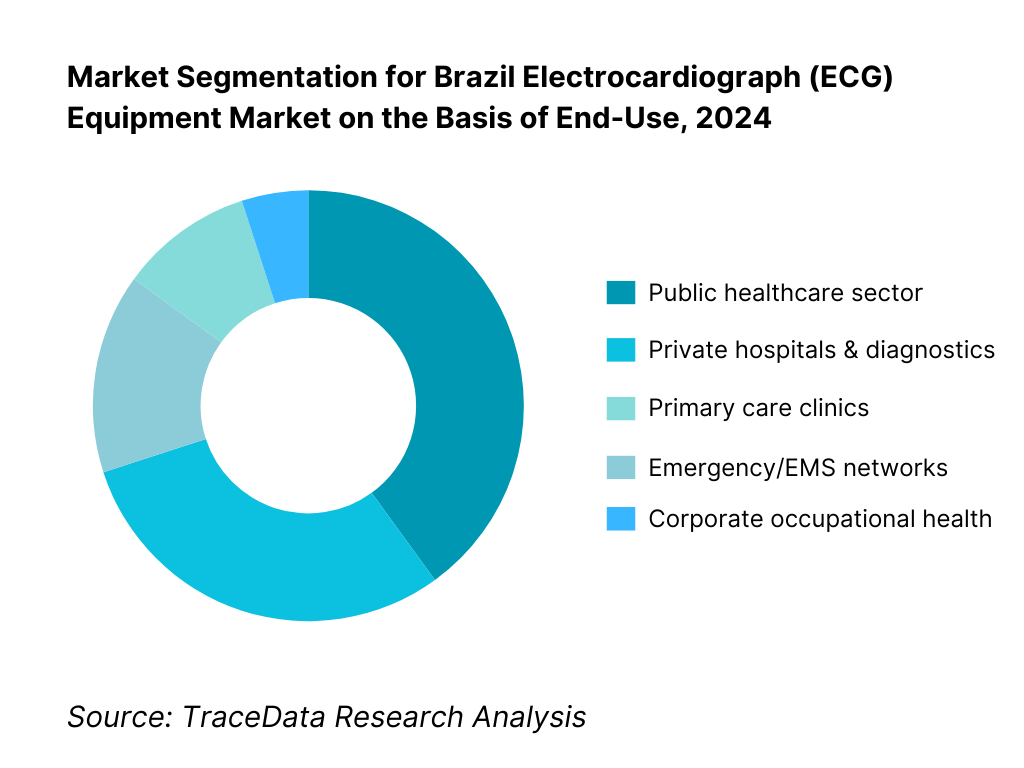
Competitive Landscape in Brazil Electrocardiograph (ECG) Equipment Market
The Brazil ECG equipment market is led by both global and local players, showcasing a balanced competitive landscape. Established multinational firms such as GE HealthCare, Philips, and Nihon Kohden coexist with domestic manufacturers like TEB and Micromed, emphasizing product localization, service reach, and compliance with Brazilian standards.
Name | Founding Year | Original Headquarters |
GE HealthCare | 1892 | Chicago, USA |
Philips Healthcare | 1891 | Amsterdam, Netherlands |
Nihon Kohden | 1951 | Tokyo, Japan |
Mindray | 1991 | Shenzhen, China |
Schiller | 1974 | Baar, Switzerland |
Fukuda Denshi | 1939 | Tokyo, Japan |
Edan Instruments | 1995 | Shenzhen, China |
Bionet | 1999 | Seoul, South Korea |
Contec Medical Systems | 1996 | Qinhuangdao, China |
Cardioline | 1962 | Trento, Italy |
Spacelabs Healthcare | 1958 | Washington, USA |
TEB – Tecnologia Eletrônica Brasileira | 1978 | São Paulo, Brazil |
Micromed Biotecnologia | 1990 | Goiás, Brazil |
Cardios (Halma Group) | 1976 | Belo Horizonte, Brazil |
Ecafix | 1960s | São Paulo, Brazil |
Some of the Recent Competitor Trends and Key Information About Competitors Include:
GE HealthCare: A dominant multinational in Brazil’s ECG equipment market, GE HealthCare has expanded its digital ECG portfolio by integrating AI-enabled interpretation software into its MAC series devices. In 2024, the company also strengthened its presence in public tenders, particularly through large-scale supply contracts for resting ECG machines in state hospitals.
Philips Healthcare: Leveraging its legacy Dixtal brand in Brazil, Philips has enhanced its PC-ECG and telemetry platforms with cloud connectivity. In 2024, it partnered with several private hospital chains to integrate ECG workflows into enterprise-wide PACS and EMR systems, driving adoption of connected cardiology solutions.
Nihon Kohden: Known for its reliable bedside and telemetry ECG solutions, Nihon Kohden expanded its distributor partnerships in Brazil in 2024 to improve regional service coverage. The company also focused on training programs for clinical engineering staff, ensuring better adoption of its advanced monitoring platforms.
TEB – Tecnologia Eletrônica Brasileira: As a leading domestic manufacturer, TEB has strengthened its PC-based ECG systems and stress testing solutions. In 2024, the company focused on affordability and service reach in remote states, ensuring its products remain competitive against imports in the SUS procurement market.
Micromed Biotecnologia: A homegrown player specializing in ambulatory ECG and tele-ECG platforms, Micromed has seen increased adoption of its Holter and MAPA systems in 2024. The company launched enhancements to its cloud-based reporting software, helping cardiologists in smaller cities access remote interpretation services.
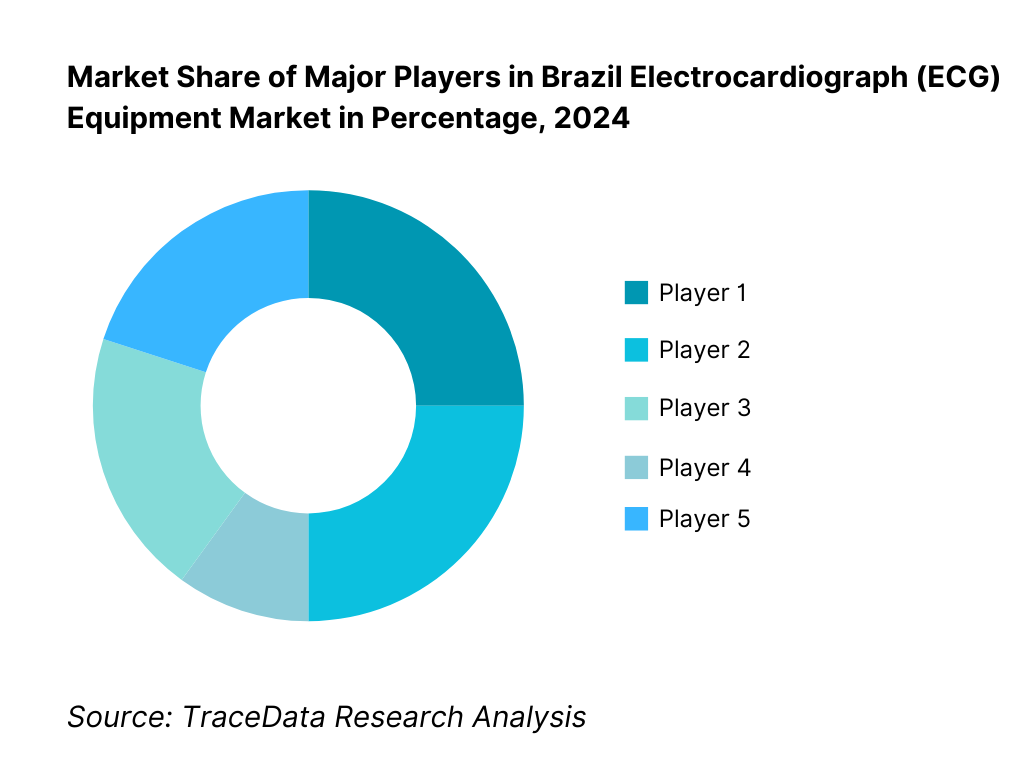
What Lies Ahead for Brazil Electrocardiograph (ECG) Equipment Market?
The Brazil ECG equipment market is expected to continue its steady expansion by 2030, supported by growing cardiovascular disease prevalence, government investments in healthcare modernization, and rising adoption of digital health solutions. This trajectory is further strengthened by demographic shifts, with Brazil’s elderly population surpassing 22 million people aged 65 and above, creating sustained demand for routine cardiac diagnostics and monitoring.
Rise of Digital and Tele-ECG Solutions: The future of ECG in Brazil will be marked by wider adoption of tele-ECG platforms, cloud-based reporting, and portable devices that connect seamlessly with electronic health records. This shift is driven by the need to extend cardiac diagnostics to underserved regions and optimize patient triage in urban centers.
Integration of AI and Smart Diagnostics: Artificial intelligence–enabled ECG interpretation tools will gain momentum as hospitals and diagnostic labs demand faster and more accurate reporting. These tools will support cardiologists in identifying arrhythmias, ischemia, and complex patterns, thereby improving efficiency in high-volume facilities and strengthening clinical decision-making.
Expansion in Public Healthcare and Primary Care: The SUS network of ~50,000 Basic Health Units (UBS) will remain a key deployment area for affordable and portable ECG systems. Increased government funding for preventive cardiology and procurement through centralized platforms is expected to boost adoption in primary care and emergency care networks.
Sector-Specific Growth in Private Chains and Diagnostics: Private hospital chains, diagnostic laboratories, and corporate healthcare providers are likely to drive incremental demand for advanced ECG systems with integrated stress testing, Holter monitoring, and ambulatory modules. Tailored solutions for these sectors will push vendors to diversify their offerings beyond standard resting ECGs.
Leveraging Connectivity and Interoperability: ECG systems in Brazil are set to evolve toward interoperability with national health data platforms such as Rede Nacional de Dados em Saúde (RNDS). The ability to integrate ECG waveforms into patient records and share results across providers will be a competitive differentiator, aligning with Brazil’s digital health strategy.
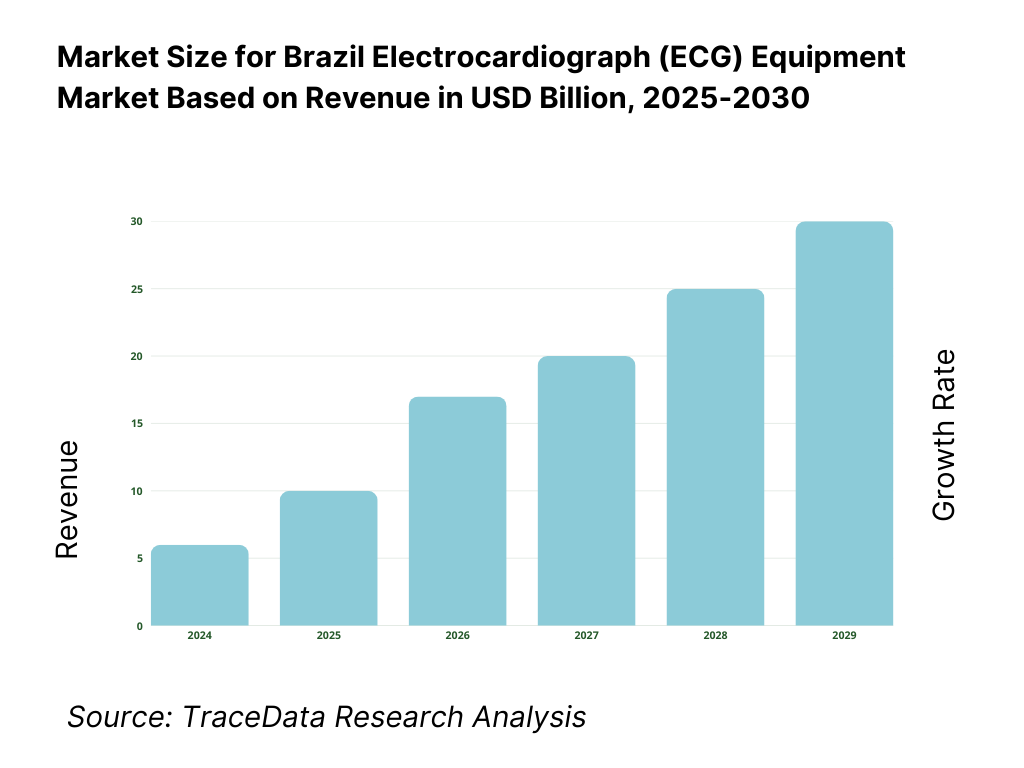
Brazil Electrocardiograph (ECG) Equipment Market Segmentation
By Product Type
Resting 12-lead ECG
Stress/Ergometry ECG Systems
Ambulatory ECG – Holter
Ambulatory ECG – Event/Loop/Patch
Bedside/Telemetry ECG Modules
PC-ECG Software & Workstations
By Technology/Form Factor
Cart-based Standalone
Portable/Handheld (battery-operated)
PC-ECG (USB/Bluetooth)
Wireless Patch/Event Recorders
Modular Patient-Monitoring ECG (plug-in telemetry)
By End-Use
Public Hospitals & Teaching Centers (SUS)
Private Hospitals (multispecialty & cardiology)
Diagnostic Labs/Imaging & Cardio-clinics
Primary Care (UBS/UPA)
Emergency/EMS (SAMU)
Corporate/Occupational Health Networks
By Connectivity & Interoperability
Standalone (paper-only)
Digital Export (PDF/CSV)
SCP-ECG compatible systems
DICOM-waveform enabled
HL7/FHIR EMR-integrated
Cloud/Tele-ECG Platforms with AI-assist
By Lead Configuration & Clinical Capability
3-lead / 6-lead screening
12-lead diagnostic
15-lead / 18-lead advanced ischemia detection
Stress-protocol capable systems
Ambulatory multi-day monitoring (24h–14d)
By Sales Channel & Procurement Model
Direct Enterprise Sales (OEM→Provider)
Authorized Distributors & Sub-dealers
Public E-Procurement (PNCP/Pregão, registro de preços)
Group Purchasing/Integrated Delivery Networks
B2B E-commerce/Resellers
Players Mentioned in the Report:
GE HealthCare
Philips
Nihon Kohden
Mindray
Schiller
Fukuda Denshi
Edan
Bionet
Contec
Cardioline
Spacelabs Healthcare
TEB – Tecnologia Eletrônica Brasileira
Micromed Biotecnologia
Cardios (Halma Group)
Ecafix
Key Target Audience
Hospital procurement directors (public sector hospitals, state health secretariats)
Private hospital chain decision-makers
Diagnostic network CEOs/CTOs
Clinical engineering leads in healthcare systems
Investments and venture capitalist firms
Government and regulatory bodies (Ministry of Health, ANVISA, BNDES)
Healthcare device distribution heads
Occupational health and primary care system administrators
Time Period:
Historical Period: 2019-2024
Base Year: 2025
- Forecast Period: 2025-2030
Report Coverage
Choose individual sections to purchase. Mix and match as you like.
- -
- -
- $100
4.1. Delivery Model Analysis for ECG Equipment [Resting ECG, Stress Testing, Holter/Event Monitoring, Telemetry, PC-ECG/Cloud ECG]-Margins, Preferences, Strengths & Weaknesses
4.2. Revenue Streams for ECG Equipment Market [Equipment Sales, Service Contracts, Consumables (Electrodes/Paper), Cloud/AI SaaS, Managed Service Models]
4.3. Business Model Canvas for ECG Equipment [Key Partners, Customer Segments, Cost Structure, Value Proposition, Revenue Flows]
$2505.1. Imported vs. Locally Manufactured ECG Equipment [TEB, Micromed, Ecafix vs. Global Brands]
5.2. Investment Models in ECG Equipment Market [CapEx, Leasing/Finame, Pay-per-use, Public-Private Partnerships]
5.3. Comparative Analysis of Procurement & Tendering Process [SUS/PNCP/Govt Tenders vs. Private Chain Procurement]
5.4. Hospital & Clinic ECG Budget Allocation by Size & Ownership
$150- $100
- $200
8.1. Revenues (Public & Private Sector Procurement, Equipment & Services)
$3009.1. By Market Structure (Public Procurement under SUS vs. Private Chains & Clinics)
9.2. By Product Type (Resting ECG, Stress/Ergometry Systems, Holter Monitors, Event Recorders, Telemetry Modules)
9.3. By End Users (Public Hospitals, Private Hospitals, Diagnostic Labs, Primary Care, Emergency Services)
9.4. By Company Size of Healthcare Provider (Large Hospitals, Mid-sized Clinics, Small Clinics/Individual Practices)
9.5. By Mode of Delivery (Standalone Cart-based, Portable/Handheld, PC-ECG, Cloud/AI-enabled)
9.6. By Region (Sudeste, Sul, Nordeste, Centro-Oeste, Norte)
$40010.1. Healthcare Provider Landscape and Cohort Analysis (Hospital Tiers, Clinic Chains, Diagnostics Networks)
10.2. ECG Equipment Procurement & Decision-Making Process
10.3. Equipment Utilization Effectiveness & ROI (Cost per Test, Throughput, Downtime, MTBF/MTTR Benchmarks)
10.4. Gap Analysis Framework (Demand vs. Installed Capacity, Urban vs. Rural Coverage)
$50011.1. Trends and Developments for Brazil ECG Market [Digital ECG, AI-interpretation, Cloud Integration, Mobile ECG Devices]
11.2. Growth Drivers for Brazil ECG Market [CVD Burden, Digital Health Adoption, Telemedicine, Federal Health Programs]
11.3. SWOT Analysis for Brazil ECG Market
11.4. Issues and Challenges [ANVISA Delays, FX Volatility, Tender Price Pressure, Training Gaps]
11.5. Government Regulations [ANVISA RDC, INMETRO Certification, LGPD, Reimbursement Codes (SIGTAP/TUSS)]
$20012.1. Market Size and Future Potential for Tele-ECG Platforms in Brazil
12.2. Business Model and Revenue Streams [SaaS, Per-Exam Billing, Subscription-based]
12.3. Delivery Models and Type of Solutions Offered [Hospital PACS Integration, Cloud ECG, AI-interpreted Reports, Wearables]
12.4. Cross-Comparison of Leading Digital ECG Providers based on Company Overview, Technology Stack, Installed Base, Revenues, Number of Tests Processed, Pricing Models, Strategic Partnerships
$500- $250
- $150
15.1. Market Share of Key Players (Basis Revenues, Units Sold, Installed Base)
$75015.3. Operating Model Analysis Framework
15.4. Gartner Magic Quadrant for ECG Vendors
15.5. Bowmans Strategic Clock for Competitive Advantage
$25016.1. Revenues
$30017.1. By Market Structure (Public vs. Private Procurement)
17.2. By Product Type (Resting, Stress, Holter, Event, Telemetry)
17.3. By End Users (Hospitals, Diagnostic Labs, Clinics, Emergency Services, Primary Care)
17.4. By Healthcare Provider Size (Large, Medium, Small)
17.5. By Mode of Delivery (Standalone, Portable, Cloud-Enabled, AI-ECG)
17.6. By Region (Sudeste, Sul, Nordeste, Centro-Oeste, Norte)
$400- $250
- $250
Research Methodology
Step 1: Ecosystem Creation
Map the full Brazil Electrocardiograph (ECG) equipment ecosystem across demand and supply. Demand-side: SUS public hospitals and teaching centers; private hospital chains; independent diagnostic laboratories; primary care (UBS/UPA), EMS/SAMU, occupational-health providers, cardiology clinics, and tele-cardiology hubs. Supply-side: global OEMs (e.g., GE HealthCare, Philips, Nihon Kohden, Mindray, Schiller, Fukuda Denshi, Edan, Spacelabs, Cardioline, Bionet, Contec) and local manufacturers (TEB, Micromed, Cardios, Ecafix); importers/distributors; service partners; cloud/AI ECG software vendors. Regulatory & payor lattice: ANVISA (product regularization), INMETRO/OCPs (IEC-60601 compliance), ANS (private payors), Ministry of Health/State Secretariats, ABIMO, cardiology societies, clinical engineering networks, PNCP/Compras.gov.br (public procurement). From this map, shortlist 5–6 priority vendors by Brazil revenue proxies (tender wins, installed base density, ANVISA registrations), market reach (regional coverage, distributor footprint), and client base (SUS programs, private chains). Sourcing leverages official portals (ANVISA, INMETRO, PNCP/Compras.gov.br, DATASUS/CNES, ANS), reputable industry publications, and proprietary databases to build an auditable baseline.
Step 2: Desk Research
Conduct exhaustive desk research integrating regulatory, procurement, and health-system data. Pull device family counts and approval histories from ANVISA; verify electromedical safety certifications via INMETRO/OCP records (IEC 60601 series). Scrape public tenders/awards from PNCP/Compras.gov.br to identify recurring specifications, awardees, and shipment cadence; mine DATASUS/CNES for facility/bed distributions and service capacity indicators; use SIGTAP/TUSS procedure catalogs to align modality mix (resting, stress, Holter/event, telemetry) with care pathways. Enrich with Comex Stat import/export traces to contextualize product flow and technology refresh. At company level, review press releases, annual filings, local subsidiary registries, technical datasheets, service manuals, and integration notes (SCP-ECG/DICOM/HL7, cloud APIs). Assemble a structured databook covering product portfolios, channel models, installed-base signals, service SLAs, interoperability features, and geographic coverage.
Step 3: Primary Research
Run semi-structured interviews with procurement directors (SUS and private), clinical engineering leads, cardiologists, and heads of diagnostic networks across Brazil’s macro-regions (Sudeste, Sul, Nordeste, Centro-Oeste, Norte) to validate demand drivers, workflow bottlenecks, and replacement cycles. Engage OEMs, local manufacturers, and master distributors to detail channel economics, service capacity, and integration timelines. Conduct mystery-buyer style procurement inquiries (ethically and without soliciting sensitive/confidential data) to triangulate delivery lead-times, warranty coverage, and training provisions. Apply a bottom-up build (units by modality × observed ASP bands; attach rates for service contracts/consumables/software) cross-checked against tender volumes, ANVISA/INMETRO activity, and health-system throughput signals (e.g., ER triage ECG intensity, pre-op screening). Capture KOL input from cardiology societies on interpretation practices, AI usage, and tele-ECG adoption outside capitals.
Step 4: Sanity Check
Perform top-down and bottom-up reconciliation. From the top, anchor on population/aging (IBGE), cardiovascular admissions and procedure intensity (DATASUS/SIH, CNES), and facility dispersion to bound realistic ECG utilization envelopes by care setting. From the bottom, stress-test vendor-reported shipments, public-award ledgers, and import flows against practical installation capacity, staffing, and service coverage. Run sensitivity scenarios (e.g., SUS budget execution variance, FX shocks affecting import pacing, INMETRO re-certification delays) and flag outliers with threshold rules (e.g., utilization per station/day, PM/MTTR norms). Iterate assumptions where variances exceed tolerance bands, and lock the model when triangulation across at least three independent evidence streams (regulatory, procurement, provider) converges. Deliver an audit trail noting sources, timestamps, and transformation logic so every figure is reproducible and defensible in client and stakeholder reviews.
FAQs
01 What is the potential for the Brazil Electrocardiograph (ECG) Equipment Market?
The Brazil ECG equipment market shows strong potential as cardiac diagnostics become embedded across public (SUS) and private pathways. Demand is lifted by a large and aging population, a persistent cardiovascular disease burden, and modernization of primary care, emergency networks, and tertiary cardiology hubs. Ongoing digitization—tele-ECG, AI-assisted interpretation, PACS/EMR integration—and clearer ANVISA/INMETRO compliance pathways support steady fleet renewal. Public e-procurement, financing options, and interoperability via national health data rails further expand installed base needs, consumables pull-through, and software/service revenues.
02 Who are the Key Players in the Brazil Electrocardiograph (ECG) Equipment Market?
The competitive field blends global and local manufacturers: GE HealthCare, Philips, Nihon Kohden, Mindray, Schiller, Fukuda Denshi, Edan, Bionet, Contec, Cardioline, Spacelabs Healthcare, and Brazilian players TEB (Tecnologia Eletrônica Brasileira), Micromed Biotecnologia, Cardios (Halma Group), and Ecafix. These companies compete on portfolio breadth (resting, stress/ergometry, Holter, event, telemetry, PC-ECG), interoperability (SCP-ECG/DICOM/HL7), service coverage, and total cost of ownership, with local vendors leveraging proximity, service reach, and public-sector credentials.
03 What are the Growth Drivers for the Brazil Electrocardiograph (ECG) Equipment Market?
Key drivers include rising utilization of cardiac diagnostics across primary care, emergency triage, and pre-operative screening; expansion of private insurance coverage and diagnostic chains that standardize ECG workflows; and accelerated adoption of digital cardiology—cloud reporting, tele-ECG hubs, and AI-aided interpretation that cuts turnaround and improves pathway efficiency. Public investment in SUS facilities and e-procurement, plus national interoperability initiatives, favor upgrades from legacy carts to connected, portable, and ambulatory ECG solutions with managed service and software layers.
04 What are the Challenges in the Brazil Electrocardiograph (ECG) Equipment Market?
Challenges include exposure to currency and import logistics for higher-end devices and components; procurement price compression in public tenders that can delay premium feature penetration; and heterogeneous IT environments that complicate EMR/PACS integration, cybersecurity, and LGPD compliance for ECG data. Providers outside major metros face training and service-coverage gaps, while vendors must navigate ANVISA dossier rigor and INMETRO certification timelines—factors that together influence launch pacing, inventory planning, and multi-year replacement cycles.